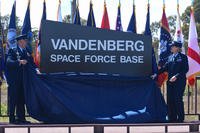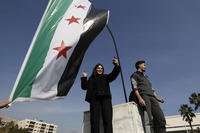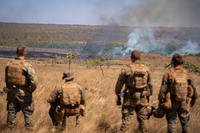LAUGHLIN AIR FORCE BASE, Texas -- Mounted aboard an armored suburban with a pistol at his side, one of Laughlin's own begins his days in Iraq checking in on classes miles apart, filled with students not unlike those he left in Texas thousands of miles from home.
Lt. Col. Chris Lachance, from Laughlin's 85th Flying Training Squadron, is one of a handful of American Airmen working to ensure that Iraqi Air force units at Al Sahra Airfield in Tikrit are getting the level of training they need to protect their skies.
"I look at the big picture of the Iraqi training mission from here to see if they are being taught and properly engaged by the American contractors and Iraqi instructor pilots," Lachance said. "I make sure Iraq is getting what it pays for."
The training, which was originally operated by the U.S., now lies in the hands of contractors and Iraqi airmen following U.S. departure from Iraq last year.
Now, just three Airmen review and advise the more than 800 civilian contracted instructors and fresh Iraqi airmen. They are tasked with training the growing population of Iraqi students set to become their nation's future maintainers, pilots and air traffic controllers.
"If you were to squish Randolph, Keesler and Laughlin together, you'd get a picture of what our base here is like," Lachance said.
Lachance, who has served in Iraq for the last three months, acts as the security assistance lead in Tikrit for the U.S. Embassy's Office of Security Cooperation-Iraq. He helps advise Iraqi squadron commanders on the finer points of pilot training.
"We are teaching them to be a lot like Laughlin," Lachance said. "A pilot here or at Laughlin would recognize the training."
Much like Laughlin's specialized undergraduate pilot training, the pilots training in Iraq begin from scratch. They learn the basics of aviation following a syllabus similar to that used at Laughlin, said Lachance. But he said there are some differences.
"We in the U.S. Air Force are selected for a specialty and then train to perform that job," he said. "Because the Iraqi Air Force is so small, they each have to do so much more and it can be a distraction."
It's not uncommon for officers and enlisted Iraqis alike to work all night and show up the next day in class with little sleep, Lachance explained.
Other differences can be found in the schedule and in the resources available to the Iraqis for training. Due to limited fuel, only 10 to 15 sorties take place per day in comparison to the more than 250 flights at Laughlin's airfield, the busiest in the Air force.
Additionally, the T-6 Texan II trainer, which is used by both countries as a key part in training, serves different roles to each, he explained. At Laughlin, like all U.S. pilot training bases, the T-6 is flown for several months before the student is sent to either the T-38 for fighter training or T-1 for tanker and airlift training. In Iraq, though, the T-6 is used as a replacement for the T-38 portion of training.
Cultural differences also play a part in what Lachance and his coworkers deal with daily. Things in Iraq are slower paced, with decisions being made after both parties slowly get to know each other.
"We want to get it done now, but they like to move slowly," he said. "Following that pace has led to a good partnership that will give us friends for life."
Regardless of the difficulties, Lachance has high hopes for the future and is thankful for the experiences he has had as an instructor pilot here at Laughlin, which have helped him prepare for his time in Iraq.
"I've seen the best and worst of pilots. Being with first assignment instructor pilots at Laughlin has helped me, because in Iraq, they are all first assignment instructor pilots starting something new," Lachance said. "There is no animosity towards us. They want to rebuild as our partner and friend. Things are going well and, although there are bumps in the road, no one is giving up."

























